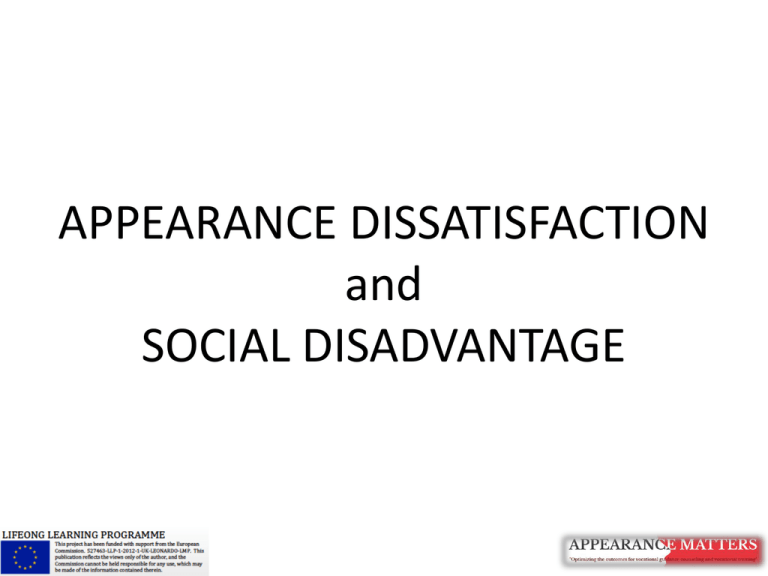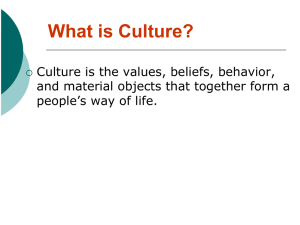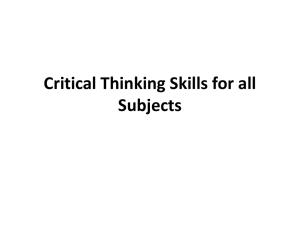
APPEARANCE DISSATISFACTION
and
SOCIAL DISADVANTAGE
DISCUSSION:
In what ways might vocational trainees from
socially disadvantaged groups be negatively
affected by their appearance?
What might the consequences be for them?
GOALS OF THIS MODULE
To enable trainers to be able to:
• Recognise risk factors for appearance dissatisfaction
in people from socially disadvantaged groups
• Understand the processes of
– Stereotyping
– Impression formation
• Discuss this topic sensitively and offer helpful advice
• Identify ways of supporting trainees and
recommending appropriate resources
SOCIALLY DISADVANTAGED GROUPS
•
•
•
•
•
People who are unemployed
Immigrants; people from ethnic minorities
People with physical disabilities
People with poor mental health
People from backgrounds with low socioeconomic status
• People with low educational attainment
WHAT IS THE ROLE OF APPEARANCE
DISSATISFACTION IN SOCIAL
DISADVANTAGE?
Appearance dissatisfaction can be a cause,
contributory factor and/or consequence of social
disadvantage…..
RISK FACTORS FOR APPEARANCE
DISSATISFACTION AMONGST SOCIALLY
DISADVANTAGED GROUPS INCLUDE
1.
2.
3.
4.
Cultural norms & beliefs
Socio-economic circumstances
Psychological vulnerability
Responses of others
1. CULTURAL NORMS & BELIEFS
ACTIVITY:
How might cultural and/or religious
beliefs impact on how trainees feel
about or behave in relation to
1. Their own appearance
2. The appearance of others
Surface Culture 10%
Doing
Thinking
Deep Culture 90%
Feeling
Surface Culture 10%
Easy to observe with vision, touch, taste, smell, sound,
Art
Dance
Food
Dress/clothing
Greetings Music
Doing
World view
Religious beliefs
Gender roles
Thinking
Authority
Ideas about leadership
Concepts of time Power
Communication
Language
Personal space
Ideas about modesty
Decision-making models
Concepts of justice
Body language
Ways of life
Laws and customs
Institutions
Methods and
Techniques
Rituals
Language
Norms
Roles
Ideologies
Beliefs
Philosophy
Definition of sin
Friendship Designation of status based on positions (e.g.,age, gender, job)
Pace of work
Feeling
Dating and courtship practices
Cooperation /competitiveness Notions of child-rearing
Deep Culture 90%
Difficult to observe
Values
Tastes
Attitudes
Desires
Assumptions
Expectations
Myths
Potential Impacts of Cultural Norms &
Beliefs
• Cultural, religious and social beliefs relating to
appearance can affect behavioural norms,
assumptions, rules and relationships (Adamson and Doud
Galli, 2009)
• May affect choices made re appearance & clothing
– Appearance ideals may differ from those in their ‘host’
country
• May affect their judgements of them by others on the
basis of their appearance, e.g, in relation to
– Socially acceptable codes of dress in host country or in a
new social group
– Beliefs about the causes of disfigurement
Examples: Cultural Differences
• Immersion in a culture with a significant
emphasis on appearance may be problematic
for some migrants….
– Although the thin ideal is present in various
cultures and is commonly adopted by adolescent
girls, it is not a universal phenomenon
– For example, in cultures based on the Confucian
value of internal goodness (such as China), less
importance may be placed on external beauty
(Chiu and Babcok, 2002).
Examples: Beliefs Attributed to Skin
Colour
Skin colour can be significant marker of social
and cultural distinction between and within
ethnic groups
• In Japan, some associate lighter skin with
greater femininity & moral virtue
• In Korea & the Indian sub-continent, some
associate lighter skin with higher social status,
privilege & respect
• In China, a lighter skin is a signifier of health
Example: Values Attributed to Ethnic
Physical Characteristics
• For some, ethnic physical characteristics can be a
source of identity and pride….but
• In many resource-rich countries, cultural, social
and economic perceptions of appearance have
led many to undergo cosmetic surgery to
diminish or eradicate ethnic origins that mark
them as different from the majority population:
– For Jewish people: noses
– For South East Asians: eyes
– For Africans: noses and lips
Example: Beliefs re Disfigurement
Religious beliefs:
• Karma - the belief that one’s actions have
consequences requiring atonement
– a person ‘deserves’ or is responsible for acquiring
a disfigurement, or
– a mother’s immoral or deviant actions from the
past or present have resulted in her bearing a
child with a visible difference
Examples: Religious & Cultural Beliefs
• Asian sub-continent: The occurrence of a
visible difference is the will of the creator –
any such characteristic should be accepted &
‘borne’ (Hughes et al, 2009)
• Iran: Those who have sustained a burn injury
are assumed to be infertile
Disfigurement: Cultural Myths
In different cultures, a cleft
lip is thought to have been
caused by
– engagement in sexual
activity during pregnancy
– seeing a rabbit when
pregnant (hare lip)
– becoming pregnant during
a lunar eclipse
– having been insensitive (in
a current or former life) to
those that have a visible
difference
Disfigurement: Gendered Beliefs
• Some cultures have a greater tolerance towards
males with disfiguring conditions, especially if
they are capable of earning a living
• “The disfigured female in the family is terribly
embarrassing” (female elder of the Bangladeshi
community living in the UK; Hughes et al, 2009).
• The loss of reproductive organs such as the
breast (for example, through cancer) is seen in
some societies as destroying a woman’s identity
and femininity (Ashing-Giwa et al, 2006).
2. SOCIAL CIRCUMSTANCES
• Social deprivation/lower income may result in
– Greater risk of obesity
– Greater risk of acquiring a disfigurement
• Burns
• Trauma
• Physical disability
– Inability to match appearance ideals
• Clothing
All of these may lead to stigmatisation and/or
shame….
Stigma and/or Shame
• For example, obesity, physical signs of eating
disorders, visible differences (scars, congenital
anomalies), physical manifestations of disease
or ill health (leprosy), or of a physical disability
or social disability,
SOCIAL CIRCUMSTANCES
• Appearance may contribute to lower
educational attainment and /or
unemployment, e.g.
– Poorer concentration; failure to engage in group
discussions (see Module xx)
– Inappropriate choice of clothing & self
presentation in interviews
– Preoccupation with self and high levels of self
consciousness leading to poor interview
performance
For example: Education
• Educational
attainment is
becoming
increasingly
important, relative
to other factors, in
shaping people’s life
chances (OECD, 2005; 2007,
2010).
Education and earnings
EMPLOYMENT STATUS
Effect of job insecurity and unemployment on health.
Taylor S Br Med Bull 2009;bmb.ldp024
© The Author 2009. Published by Oxford University Press. All rights reserved
• Social and economic
inequality and exclusion
are both a cause and a
consequence of mental
health problems &
• Poor Quality of Life
Rogers A and Pilgrim D (2003) Mental Health and Inequality. Basingstoke: Palgrave Macmillan.
Social Exclusion Unit (2004) Mental Health and Social Exclusion. London: Office of the Deputy Prime Minister.
3. PSYCHOLOGICAL VULNERABILITY &
APPEARANCE DISSATISFACTION
• Appearance dissatisfaction is associated with
– Low self-esteem
– Low self-confidence
– Negative self evaluations
– Social anxiety & general anxiety
APPEARANCE ISSUES CAN INCREASE
PSYCHOLOGICAL VULNERABILITY &
SOCIAL DISADVANTAGE
By contributing to
• Negative self-perceptions
• Fragile self-concept and sense of self-worth
• Issues of identity
• Sub-optimal social functioning because of
– A lack of social skills (due to self consciousness)
– Social anxiety
Self-concept & self-worth
• A resilient, balanced self-concept derives a sense
of worth from a variety of domains, including for
example, performance at school or at work,
friendships, sporting ability and leisure activities,
as well as appearance
• If one component is negatively affected (for
example, if another person makes a negative
appearance-related comment), then other
‘segments’ can still provide a sense of selfworth…
Well Balanced Self-Concept
Other
Sports
Appearance
Fun to be with
Academic
Good social
skills
Vulnerable Self-Concept
• As the result of pressures from the media,
fashion and beauty industries, increasing
numbers of people are defining themselves
(self concept) and evaluating themselves
primarily in relation to their appearance (self
worth).
• This increases their vulnerability to low selfworth, as they have little to fall back on
Vulnerable Self-Concept
Other
Appearance
Identity & Appearance
• Identity is derived in part
from appearance –
appearance norms relate to
shared customs, practices
and cultural values that are
based on nationality and
ancestry, ethnicity &
religion
• People experience pressure
to conform to socially
defined norms of
appearance to facilitate
group membership or
convey status
4. RESPONSES OF OTHERS
These can include
a) Stereotyping on the basis of appearance
– By professionals
– By peers
– By potential employers
b) Appearance talk amongst peers; family
c) Social Relationships (eg friendship choices)
determined on the basis of appearance
a) Stereotyping
• Humans have an innate tendency to
categorise others on the basis of external
characteristics
• Stereotypic judgements are made on the basis
of which characteristics are socially valued,
desired & acceptable
• These judgements are influenced by cultural
and religious beliefs and by social norms
Where do Stereotypes Come From?
Family
Friends
Media
Family
• Through the modelling
of attitudes and
behaviours
• Through comments
made about
appearance
• Influencing eating and
exercise patterns
Friends
•
•
•
•
Peer pressure to conform to group norms
Friendship choices
‘engaging in appearance-talk’
Teasing; bullying
Bullying
• Can occur across the
lifespan
– In educational settings,
reports state that up to
20 – 25% experience
bullying.
– 21% say that bullying is
an issue where they
work
(Trades Union Congress, 2008).
• Bullying is commonly
based on the following
characteristics
–
–
–
–
–
Physical appearance
Disability
Sexual orientation
Intellect
Socio-economic
background
– Cultural or religious
background
Bullying
• Studies show that students with visible and
non-visible disabilities are subject to more
bullying than non-disabled peers (Carter and
Spencer, 2006).
• Research has shown that students who are in
the ethnic minority in a school are more likely
to be bullied than students who are in the
ethnic majority (Graham, 2006). Ethnicity is
often inferred on the basis of appearance.
Media
• Through the transmission of
appearance ideals in TV,
magazines, cinema,
advertising and the internet
• Articles identifying ‘faults’
in appearance
• Advertisements for
products to correct these
‘faults’
• Advertisements and articles
extolling the benefits of
cosmetic surgery
The villain in Disney’s 2013 movie “Lone Ranger” is portrayed with a cleft lip
Stereotyping on the Basis of
Appearance
• Girls associate thinness with being happier,
healthier, better looking, and more successful
with boys (Wertheim et al., 2009)
• Negative stereotypes/stigma are associated with
a visible disfigurement
• This stereotyping can result in stigmatisation and
can devalue the whole person
BUT……OUR INITIAL STEREOTYPES (often based on
appearance) ARE FREQUENTLY WRONG!
Influencing first impressions
(What can we do when we say
‘hello’?)
• Looks do count in first impressions….but other
factors come into play after the first 10-15
seconds
• Other factors influence
impressions too, including
– Smiling
– Eye contact
– Social skills
DISCUSSION
• What kinds of stereotypic judgements might be
made about trainees from socially disadvantaged
groups
• By whom?
• What might the impacts of these stereotypic
judgements be?
• How might the trainers and trainees influence
these judgements
1. At the time the judgements are made?
2. Afterwards?
b) Appearance Talk & Appearance
Comparisons
• ‘Appearance Talk’ refers to comments and
conversations about a person’s own appearance, or the
appearance of others. These comments are usually
disparaging (e.g. “I look so awful”; “I am so fat”; My
skin looks terrible’’)
• Appearance ‘comparisons’ are the process of
comparing (usually negatively) one’s own appearance
or the appearance of others to an ideal (eg models in
the media) or a specific ‘target’ (such as a celebrity)
Both processes are common amongst older adolescents
and young adults. Both contribute to body dissatisfaction
ACTIVITY
• In the context of vocational guidance or
vocational training, when might ‘appearance
talk’ take place?
• Are you aware of these taking place amongst
your colleagues and/or students?
• What might be done to discourage such
conversations ?
HINTS & TIPS TO REDUCE
APPEARANCE TALK
• Change/divert the conversation to another topic
• Focus on a person’s qualities (eg their
personality) rather than their appearance
– S/he is friendly; generous; has a great sense of
humour
• Avoid value judgements (eg “beautiful”; “looks
amazing”) and focus on facts instead
– Taller; shorter
• Engage in ‘health talk’ not ‘appearance talk’
– Encourage students to exercise to improve fitness &
function – not to lose weight
HINTS & TIPS ABOUT APPEARANCE
COMPARISONS
• Comparisons are difficult to avoid altogether –
it’s something we all do…..but
• Encourage your trainees to choose realistic
targets for their comparisons, eg
– People of their own age & occupation
– Their peers, rather than celebrities
• Apply this principle to yourself too!
c) Social relationships
• Research has established that children and
adolescents prefer attractive peers as playmates,
friends, and even as partners for an academic
project (e.g., Boyatzis, Baloff, & Durieux, 1998)
• Appearance may affect friendship choices, and
choices about whom to work with in class
• Social contact is a good way of breaking down
stereotypes – so if you think this may be
happening, ensure those ‘at risk’ are included in
work groups
POTENTIAL IMPACTS OF APPEARANCE, STEREOTYPES
& APPEARANCE DISSATISFACTION
•
•
•
•
Social exclusion on the basis of appearance
Reduced likelihood of employment
Risks to wellbeing
Appearance dissatisfaction in trainees &/or
appearance preferences made by their peers
(or trainers) may compound existing
inequalities/difficulties/challenges
ADDRESSING APPEARANCE-RELATED
CHALLENGES
• Promote discussion about appearance-related
norms of the ‘host’ countries of migrants
• Educate trainees about the processes of
stereotyping & forming first impressions and
how to influence these
• Encourage a reduction in appearance talk
• Encourage appropriate targets for appearance
comparisons
• Promote social inclusion in work groups
SUMMARY
• Cultural & religious beliefs and social norms
can influence self-perceptions and the
responses of others to a person’s appearance
• Appearance plays a part in the responses of
others (e.g. in the form of stereotyping and
forming impressions
• Appearance issues may compound the
impacts of social disadvantage
Appearance & Social Disadvantage
Failing school
Mental Health
Unemployment
SUMMARY
• Trainers and counsellors can optimise the
chances of positive outcomes by
– Improving understanding about the values, beliefs
and norms of different cultures and ethnicities in
relation to appearance and/or disfigurement
– Increasing awareness amongst trainees and
colleagues about the processes of stereotyping
and forming impressions
– Tackling appearance talk
– Encouraging appropriate appearance comparisons





